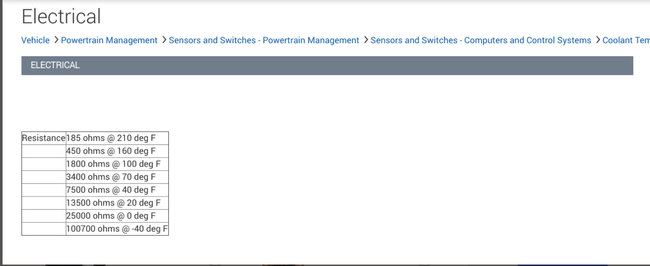I put together my own worksheets to walk my students through the operation of these sensors. During that shop class, I insisted they write down the exact voltages for the coolant temperature sensors as the engines warmed up. To their surprise, what they found is exactly what you just described, and that is correct and normal operation.
If we switch for a minute to the throttle position sensor, it has a long resistor element inside it. If you look at it as two resistors tied together, the junction is the point where the movable contact is along that element. The ratio of those two resistor values changes as the contact moves along it, but the total of those two resistors remains constant.
The TPS relies on a mechanical change to effect a change in the signal voltage. The same thing happens with the coolant temperature sensor, except it relies on a chemical change within the resistor in the sensor. On the TPS, it gets 5.0 volts and ground supplied to it, and the signal wire comes off between them. The CTS is the same circuit, except the 5.0 volts is supplied to that circuit inside the computer. Only the ground and signal wires are found at the sensor. As the TPS can be thought of as two resistors, the same is true of the CTS. One resistor is inside the sensor. It changes value with changes in temperature. The second resistor is inside the computer. We'll call that the "dropping" resistor.
As coolant temperature rises, the resistance in the sensor drops. With less total resistance in the circuit, current increases, so more of the 5.0 volts is dropped across that dropping resistor inside the computer. With more of that 5.0 volts used up, what you see on the signal wire goes down. Normal operation is to see roughly 4.0 - 4.5 volts on the signal wire with a really cold engine, then it slowly drops to around 1.5 - 2.5 volts by the time the engine gets to perhaps 120 to 160 degrees.
Here's where you and my students think the problem occurs. Suddenly the voltage jumps back up to around 3.5 volts, then gradually drops again as the engine continues to get up to normal temperature. What has happened is the computer needs to have more accuracy near normal temperature. It gets that by switching in a different dropping resistor.
With a cold engine, the temperature range might go from -39 degrees to around 160 degrees, and the CTS signal voltage drops maybe 2.5 volts. It takes a real big temperature change to make the signal voltage change just a tenth of a volt. With the new dropping resistor switched into the circuit, now that 2.5 volt change covers a much smaller temperature range, from roughly 160 degrees to around 230 degrees. That's a 70 degree range compared to a 200 degree range with the cold engine. That is how the computer gets more accuracy during normal operation.
I've never included this description before because it just adds to the confusion, but the tests you did confirms the circuit is working. You should find the radiator fan does not get turned on when you have those normal readings. It's starting to sound to me like you have an intermittent connection in the sensor's connector, or there's an intermittent break in one of its wires. The common test involves unplugging the CTS with the ignition switch on. As a default in case the engine is running too hot, the computer turns the fan on as a precaution.
Saturday, February 15th, 2020 AT 6:12 PM
